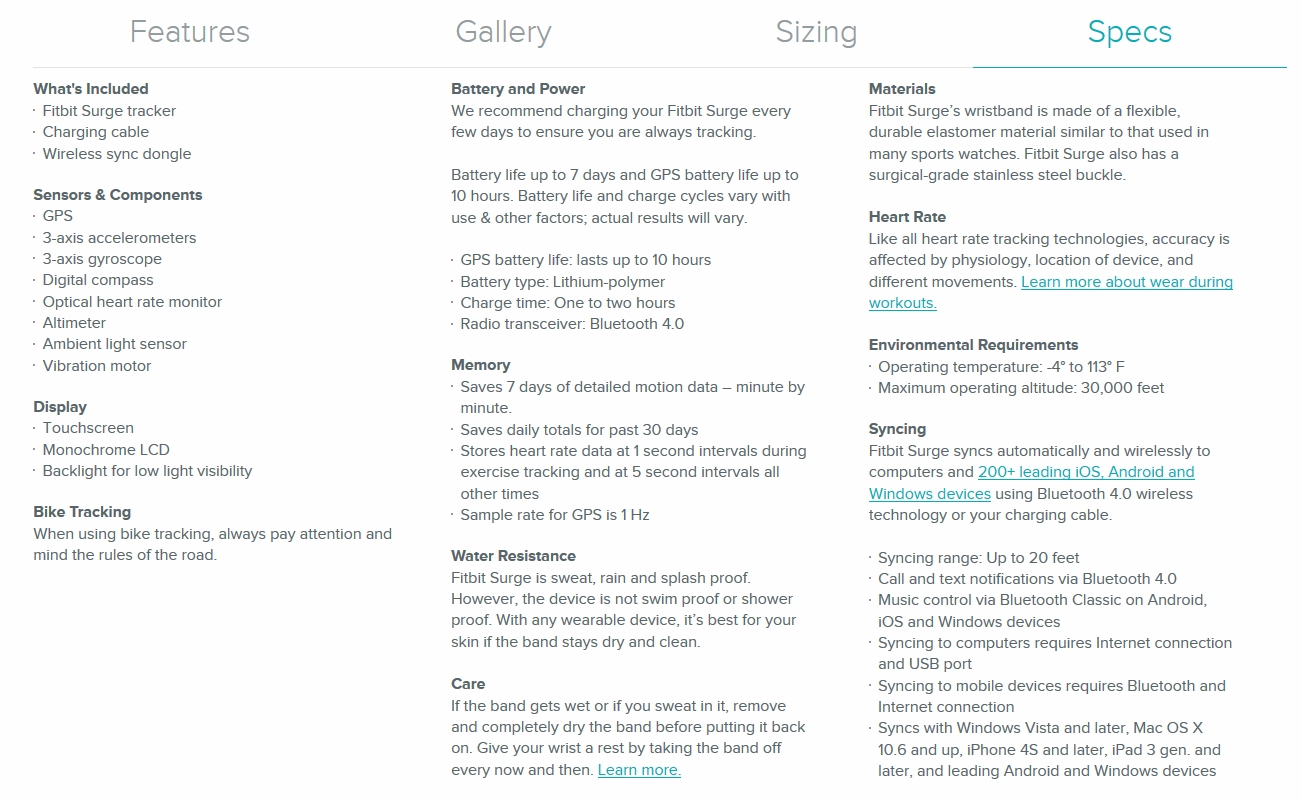For today’s Training Tuesday, we’re taking a look at a tech-packed gadget that might just help you with you better monitor your training. It may not give you wattage reports, but it attempts to monitor all your activity, on and off all your bikes. After an initial hiccup, we’ve got our full review of the Fitbit Surge smart watch with GPS and heart rate monitor. Does it live up to Fitbit’s “Fitness Super Watch” name? Read on.
Heart rate monitors for athletes have been around for forty years now, and GPS head units for several decades. But the watch? The wristwatch has been around for centuries. In fact, 101 years ago The New York Times described pocket clocks attached to bracelets as a “silly ass fad.”
It seems like that fad has some legs, legs that have withstood the test of time, if you will. However, the latest fad is to combine them with heart rate monitors or GPS trackers or sometimes, both. Fitbit, one of the leaders in fitness tracking devices, got its start helping people measure steps per day, but has continuously expanded its target market, now aiming at more serious athletes who care more about heart rate, distance and Strava KOMs. Whether intentionally or not, it’s created a product for athletes who care about data, not necessarily to compare with others but as a personal reference and lazy form of note taking.
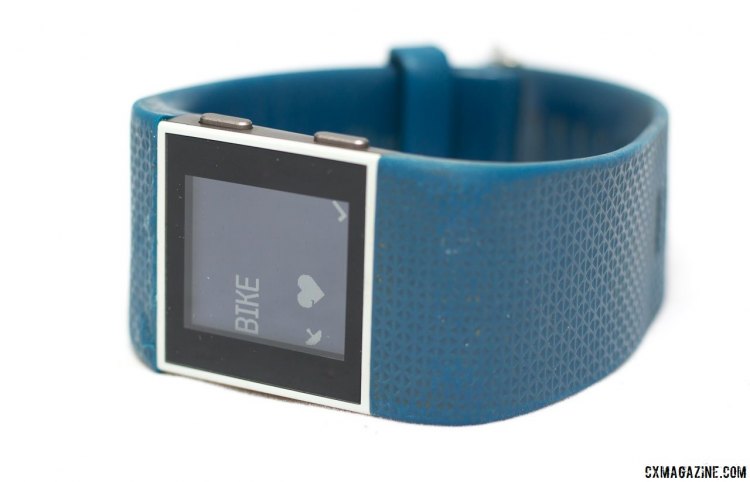
Fitbit Surge GPS/heart rate monitor smart watch makes recording rides easy but there’s an unnecessary extra step. Swipe to Exercise, then Bike, click the bottom right button and wait for GPS confirmation before starting the recording. It’s easy to forget the last step after you’ve already confirmed the check mark. © Cyclocross Magazine
Last year, we received a $199 Fitbit Surge smartwatch for review called by Fitbit its “Fitness Super Watch.” At the time, it was Fitbit’s only GPS-enabled tracker, and remains so, although another model is on its way. It worked for a bit, then failed to come back to life after a charge. Fitbit sent out a replacement, and the electronics have been reliable and operational since.
Here are the features it carries:
The appeal of a watch like the Fitbit Surge is its all-in-one and always-with-you nature, not clinical-grade accuracy. I tested most of the above features over several months. Here are some of my conclusions.
Easy, Convenient GPS Tracking for Cyclocross, but Maybe Not Gravel
This is simply the best device I’ve ever had for easily GPS tracking rides. It’s not specifically because of the user interface or speed, but because if you wear it as a daily watch, it’s always on you, and it auto syncs very quickly with your phone (and then uploads to other services you’ve connected it with).
Us cyclocrossers often make a habit of switching bikes, even if you’re not reviewing several at once like we often do at Cyclocross Magazine. Maybe you train on the road bike or trainer, race your A bike, swap to your B bike during the race or for a training session. If you’re using a Garmin or other head unit, that’s a lot of bike mounts to own, or tedious switching of the mount between bikes. And during a race? Forget about it. If you’re tracking everything on your watch, well, you can switch bikes every half lap and have it all recorded.
Getting the data off your watch is as easy as can be. The less I need to think about after a ride, the better. Before I’m even curious about any data from my ride, it’s already on my phone, and likely uploaded to services like Strava. You don’t need a cable to download a ride, and don’t need to manually sync with a mobile app. Sure, the latest head units and other watches like the Suunto Ambit 3 have similar Bluetooth capability, but this has been the most automatic and fastest that I’ve tested. Can’t wait? You can use the app to manually sync the ride as soon as you climb off the bike.
Three Buttons, A Touch Screen and Cyclocross Battery Life
The interface is intuitive enough. Tap and swipe the watch to get to the Exercise screen, select Bike, and then wait for GPS confirmation and hit start. I’d much prefer the ability to start recording right away, even if GPS triangulation hasn’t been finalized, as more than once have I hit “Bike” and then started to pedal, only to forget to hit start when it finished establishing its location. No ride recorded. That’s one of my biggest complaints.
If you get through that process without a glitch, the rest is relatively smooth sailing. The watch displays your elapsed time and distance, and allows you to swipe through heart rate, average speed, clock and calories. The touch screen doesn’t appear to need special gloves—it has worked fine with most full finger gloves, but no guarantees with lobster mitts in the middle of winter. Certain riding positions and gloves might be conducive to accidentally hitting one of the two right-side buttons—it wasn’t uncommon for the watch to switch from showing heart rate to calories or clock, for example, even when I didn’t consciously switch displays.
One button stops and pauses a ride, and then you decide whether to end it or restart it. Once you end a ride is where the Fitbit Surge really shines. Assuming your phone is near, it’s logged on your phone, and a few minutes later up on services like Strava or MyFitnessPal. Only the most OCD KOM hunter would be unhappy with the speed of the automagic upload via Bluetooth.
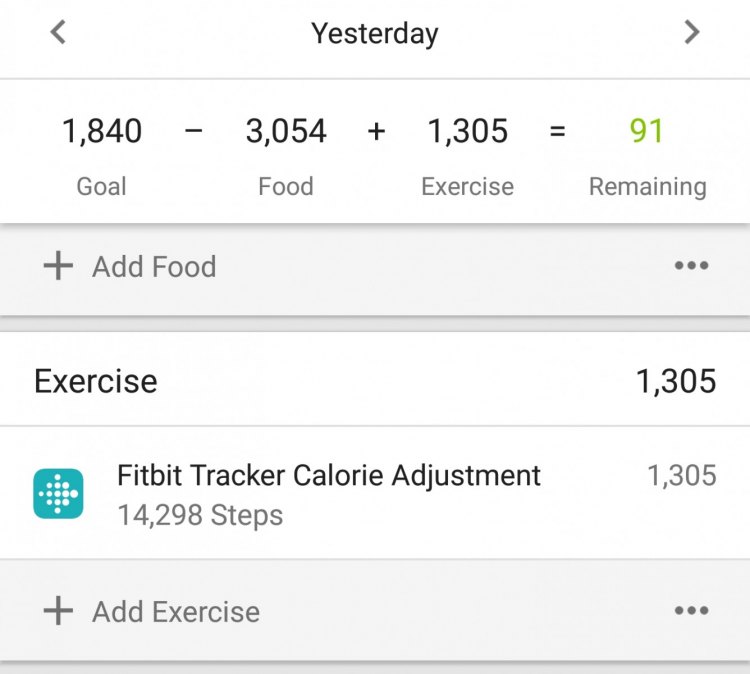
The Fitbit Surge GPS/heart rate monitor smart watch and mobile app will automagically sync with other services, including MyFitnessPal and Strava and attempt to give these services a clearer picture of daily activity and help you track total calories in and out. While Fitbit and MyFitnessPal report activity as steps, sometimes the calorie burn estimates are from rides with heart rate and GPS data. © Cyclocross Magazine
Sure, watches like the Suunto Ambit 3 (reviewed here) offer similar connectivity, but the syncing is more cumbersome and far slower, and at least for me, has never been automatic, regardless of settings. If you’re impatient and need to initiate a sync immediately after a ride, the Fitbit Surge takes seconds, not minutes like it does with a Suunto Ambit 3.
I say the GPS tracking is great for cyclocross, not gravel, because of battery life. I don’t know about you, but it’s rare that I’m charging my watch right up to the minute before a workout or race. On paper, the battery of the Surge might last for the duration of your day-long gravel grinder, but show up without it topped off, and you’re bound to have a blank screen before your ride is done. That’s frustrating.
At half battery, the Surge will still record your hour-long cyclocross race without issue, and be around to help you make it home in time before your hall pass expires.
Monitoring Off the Bike
To estimate heart rate, the Fitbit Surge uses the company’s PurePulse technology, which is essentially two optical LED lights that attempt to monitor capillary action on your skin. Studies are conflicting as to the accuracy of the technology. While Consumer Reports tests have confirmed similar accuracy to an EKG (chest strap) monitor, plaintiffs for a lawsuit and reviews other have indicated relatively large discrepancies in heart rate readings from Fitbit PurePulse devices.
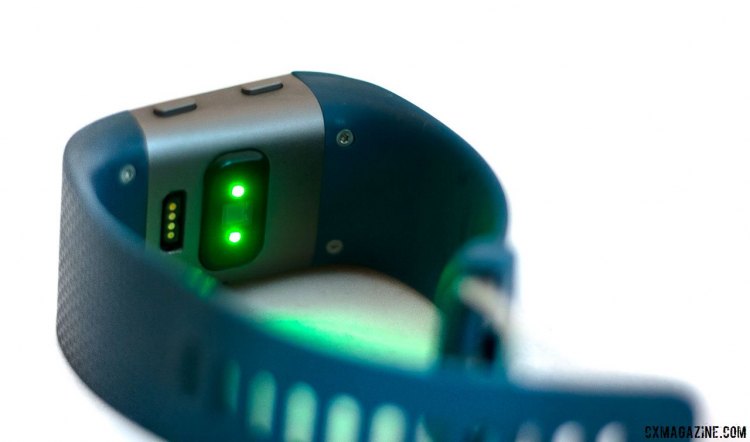
Fitbit Surge GPS/heart rate monitor smart watch uses optical LEDs to monitor capillary action. It seems accurate during normal daily life, but can lag or have gaps when you start to get going. Buy it for the easy-to-use GPS, but not for heart rate accuracy. © Cyclocross Magazine
My own experience indicates the Surge is quite accurate until hard efforts or bumpy rides. Resting pulse seems to be dead on, and during an easy spin, it seems to be pretty close. It’s when I’m going really hard, or perhaps on bumpy terrain, then it seems off. For me, it either wasn’t registering any heart rate or seemed to be very delayed in noticing an increased effort. For many, that’d be an instant deal breaker, especially if you’re using it to monitor an effort and regulate an effort, especially if it’s to heed a doctor’s orders or coach’s training plan.
For others, and I’m finding myself more often in this bucket, the Surge offers an interesting ’round-the-clock monitoring that I wouldn’t get with EKG-based monitors unless I wore the strap around the clock as well. The results of that are resting heart rate and sleep tracking:
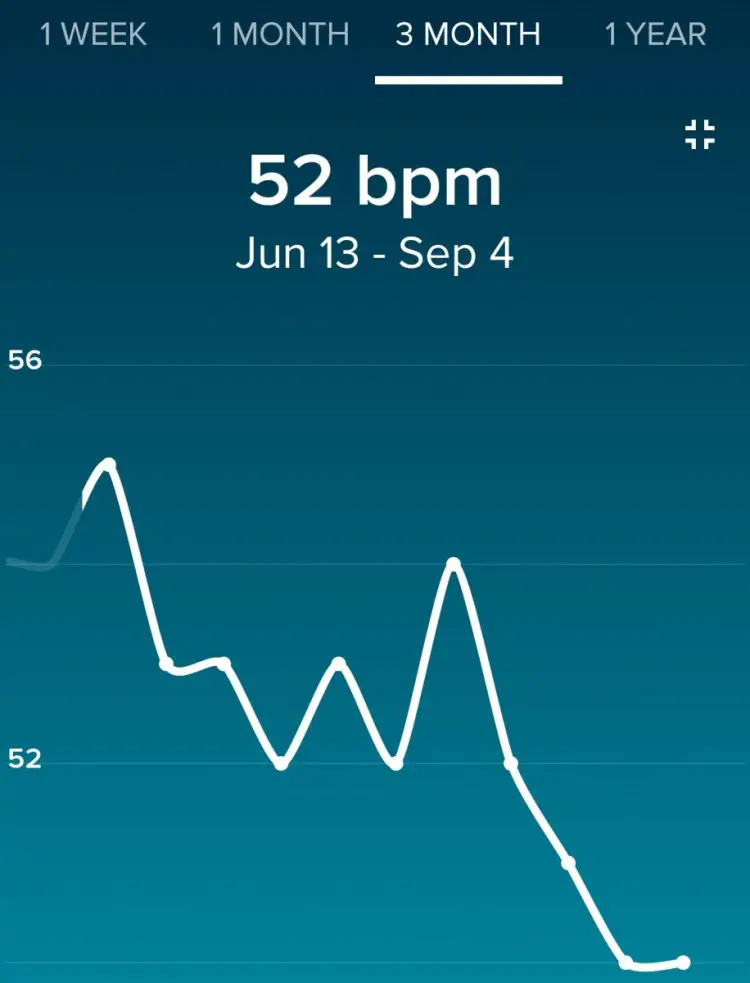
The Fitbit Surge GPS/heart rate monitor smart watch, because it can be “always on,” gives you some additional data like resting heart rate that other monitors can’t, unless you wear the chest strap constantly. While the accuracy is contested, trend lines should be revealing. © Cyclocross Magazine
One of the main benefits of such a watch, compared to a head unit is its ability to monitor key off-the-bike time, like your ultra-critical recovery time (sleep). Clearly, this athlete isn’t serious enough about his performance. Fitbit Surge GPS/heart rate monitor smart watch. © Cyclocross Magazine
The Surge’s visibility into modest increases in heart rate during the day is useful for monitoring calorie burn or helping with weight loss. If it doesn’t reflect my true heart rate and effort during an interval session or race, it’s alright, because I’m not focused on heart rate during such efforts.
I played with Fitbit’s food diary, but found it to be severely limited in its food database compared to one of the leaders, MyFitnessPal. Fitbit might realize this, as it at least plays nicely with the competing service.
The Calorie Counter’s Calculator
Whenever you can add any heart rate data to step counts, you’re bound to get more accurate daily calorie burn counts than just estimating based on pure movement. Sure, the Surge’s heart rate monitoring technology isn’t as accurate as a chest strap, but it has some sense when you’re laboring up a steep, rocky hill at altitude rather than taking an easy stroll down the street.
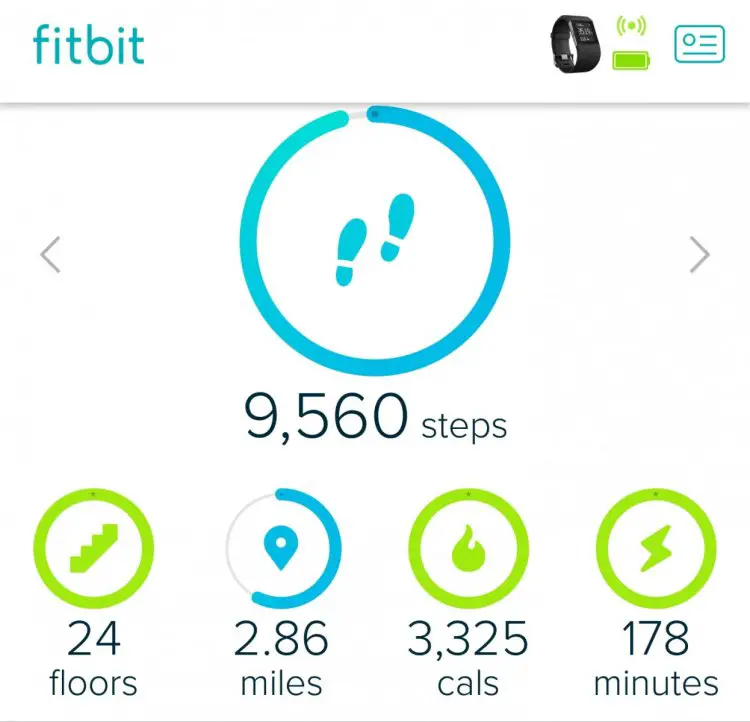
Fitbit Surge GPS/heart rate monitor smart watch syncs with your phone, and gives you estimations of activity level and calories burned. © Cyclocross Magazine
That’s pretty handy, especially if you’re tracking calories. During a dinner with some Carmichael Training System coaches and athletes, I heard criticisms from people using Fitbit’s calorie burn estimations, partly because it would overestimate the calorie burn for fit, efficient athletes. But because of the heart rate monitor, I’ve found it to be much closer to power meter-based calorie burn estimations of rides than Strava estimates (without power data). Strava doesn’t know whether you’re riding off road and doesn’t seem to consider micro-changes in terrain. For example, after an hour of racing around a pump track but riding just a few miles total at a pretty slow speed, Strava guessed I burned a bit over 200 calories, while the Fitbit Surge, with some visibility into my heart rate, reported triple that. Based on my perceived effort, I’d bet the Surge was far closer.
It’s not without its limitations though. The Surge attempts to auto-recognize activities and factor them into calorie counts. It gets a bit confused when I ride my bike around town on errands and yet don’t tell it I’m on a ride. In the end, I see a bunch of steps that I know I didn’t take, and some “bonus” calories burned that I probably don’t deserve. Disciplined logging of each ride would help avoid such an issue, but I’m not always thinking of logging a ride to work in the local coffee shop.
Notes on Notifications
Like most smart watches, including the Suunto Ambit 3, the Fitbit Surge offers notifications of text messages and calls. The call notifications are useful, as they can tell you who is calling without pulling out your phone from your jersey pocket. The text messages for me were pretty useless. They are limited in characters and real estate, and perhaps because of the frequency of them, were just another distraction.
Fitbit offers other notifications in the form of email summaries of your weekly activity. While data geeks can argue over the level of accuracy, the trend lines can be interesting and helpful. Perhaps the report will just remind you of the obvious, like perhaps the best thing you could do is just get more sleep:
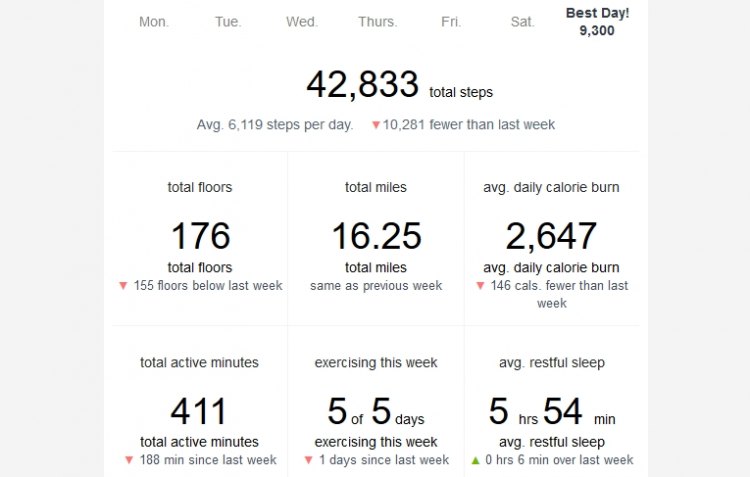
Fitbit emails you a report each week on your status. It may not be super accurate for steps and calories, but trend lines can be informative. Unfortunately, the reports do not include mileage from bike rides.
One notification that works great but is typically unwelcome is its alarm. You can set one or two “Silent Alarms” that are vibration only (more on that below), letting anyone else stay dreaming while you debate snoozing longer. The alarms aren’t the only thing silent on the watch, as it doesn’t have any kind of beep whatsoever.
Smart but not Perfect
You’ve already read some nitpicks above with the user interface and battery life, but my two biggest complaints are with the stated waterproofness, and with the strap.
Fitbit states in the watch’s specs that the owner needs to dry the band off after sweating and it can’t handle showers, let alone swims:
Water Resistance
Fitbit Surge is sweat, rain and splash proof. However, the device is not swim proof or shower proof. With any wearable device, it’s best for your skin if the band stays dry and clean.
Care
If the band gets wet or if you sweat in it, remove and completely dry the band before putting it back on. Give your wrist a rest by taking the band off every now and then.
I believe that any watch that calls itself a “Super Fitness Watch” should be more than prepared to handle a shower or swim, and shouldn’t need special care after some sweat. I’m the kind of person who never takes his watch off—unless it needs charging. Perhaps because I got it wetter than ideal, this well-documented problem happened with the wristband:
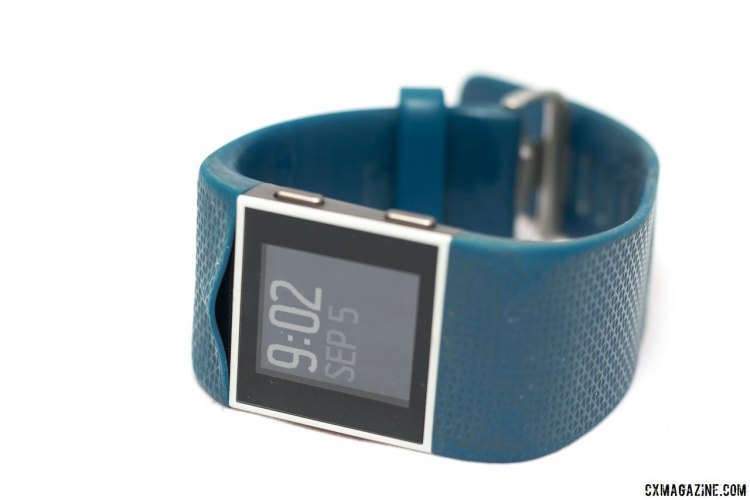
Fitbit Surge GPS/heart rate monitor smart watch should bubble up on your list for simple GPS recording, but the wristband could also develop bubbles after a few months of heavy use. A few drops of Super Glue was a quick fix, but the company has been replacing such units under warranty (1 year, but 2 years in the EEA). © Cyclocross Magazine
However, knowing that I didn’t remove it every time after sweating (which can happen in the summer even without a workout) and might have forgotten to take it off before a shower or two, I attempted to address my own neglect with a few drops of super glue, and eight minutes later, this was the result:
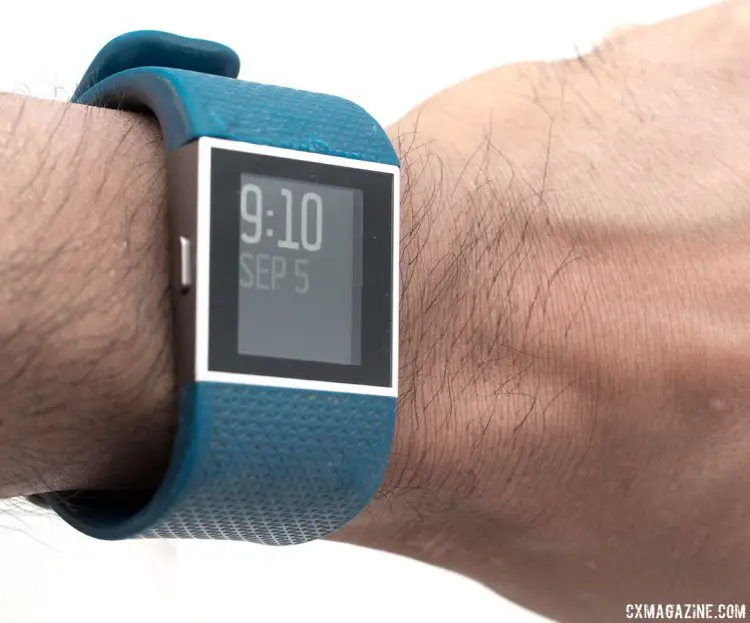
Fitbit Surge GPS/heart rate monitor smart watch comes in different colors isn’t so big that it looks out of place as a daily watch. © Cyclocross Magazine
Fitbit must have been tired of similar complaints and warrantying wrist bands, as its upcoming Ionic GPS watch has 50m of water resistance. That’s more like it, but you’ll pay another $100 for the waterproof case (along with a color screen and music storage).
One other frustration I had was with the alarm. In a baffling decision, Fitbit made your phone and its mobile app essential to setting and configuring alarms. Digital watches have always had alarms that you can set and configure on the watch, and to strip that functionality away on a $199 device that offers so much advanced technology doesn’t make any sense to me. You’ll feel the same if you don’t always have your phone right next to you when you sleep, but lay down in bed and want to set your alarm for Sunday’s cyclocross race.
Splurge on the Surge?
The $199 Fitbit Surge is a somewhat-flawed first foray into GPS-enabled smart watches, and the upcoming $299 Ionic looks to have resolved some of those flaws—we’re anxious to see if that’s indeed the case. There’s also the $198 Blaze that offers more features and a color touch screen but relies on your phone’s GPS for tracking rides.
Yet if you’re looking for a simple device to track different workouts, including your rides on different bikes, it’s hard to fault choosing the Surge as a convenient option.
Despite its flaws, the Surge has pretty much secured its place on my wrist for cyclocross season, at least until I start to sweat the little details and dry off its wristband.
Fitbit Surge GPS / Heart Rate Smart Watch Specs:
MSRP: $199
Features tested: GPS, heart rate monitor, phone notifications, alarms, stopwatch, timer, sync with Strava, MyFitnessPal, and weekly email summaries.
Features not tested: Bluetooth music control
Colors: Blue, Tangerine, Black
Sizes: S, L, XL
More info: fitbit.com or Amazon












